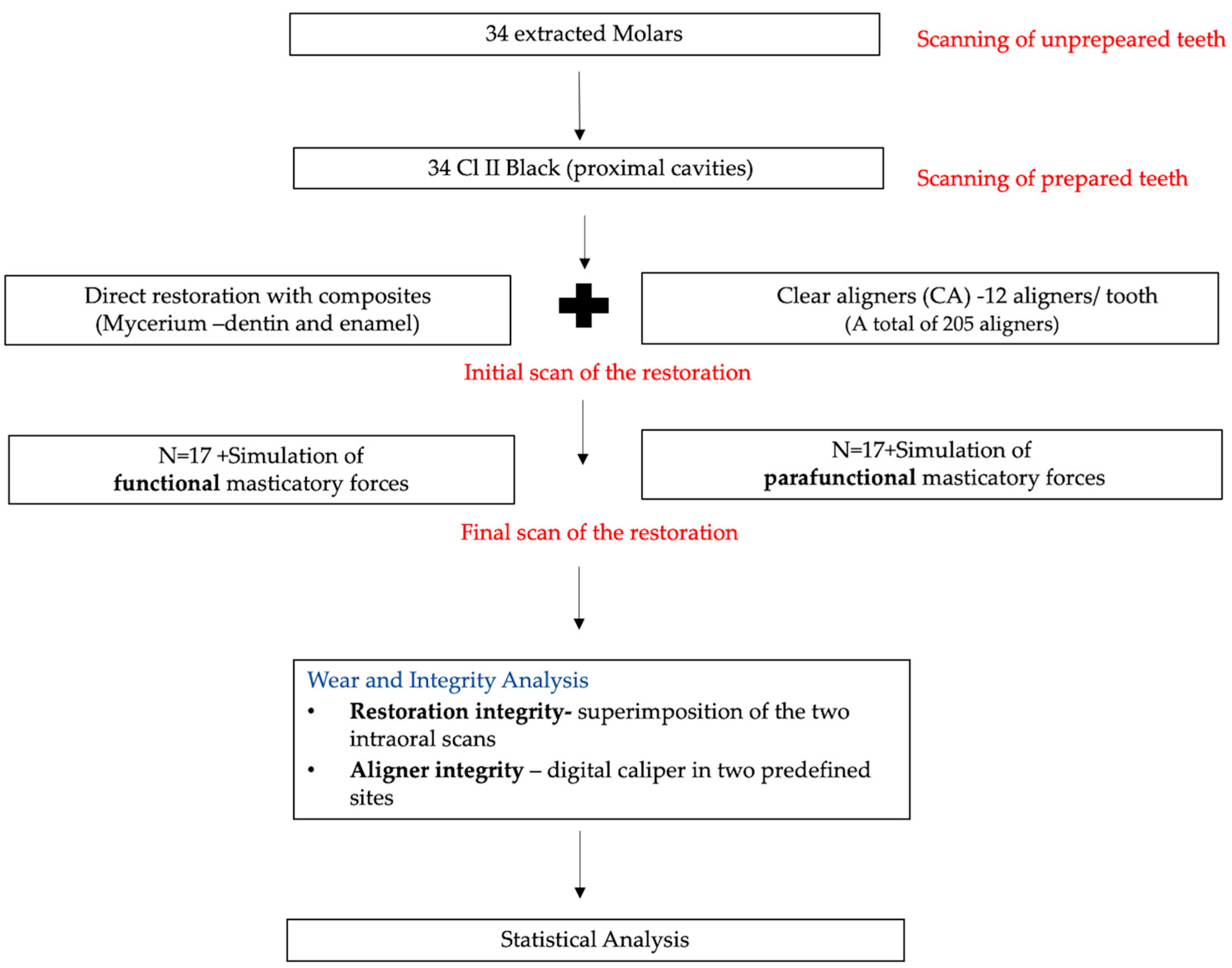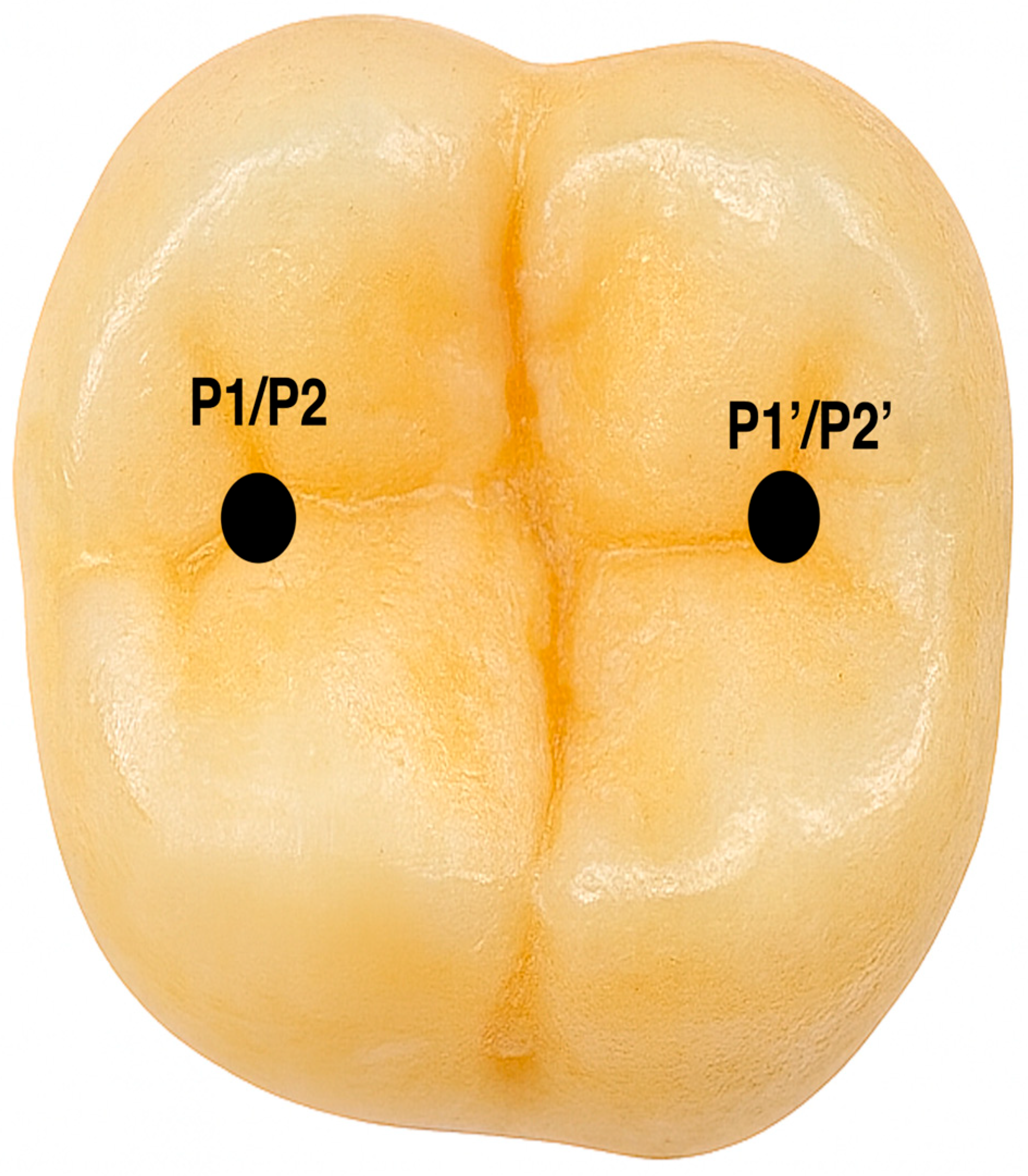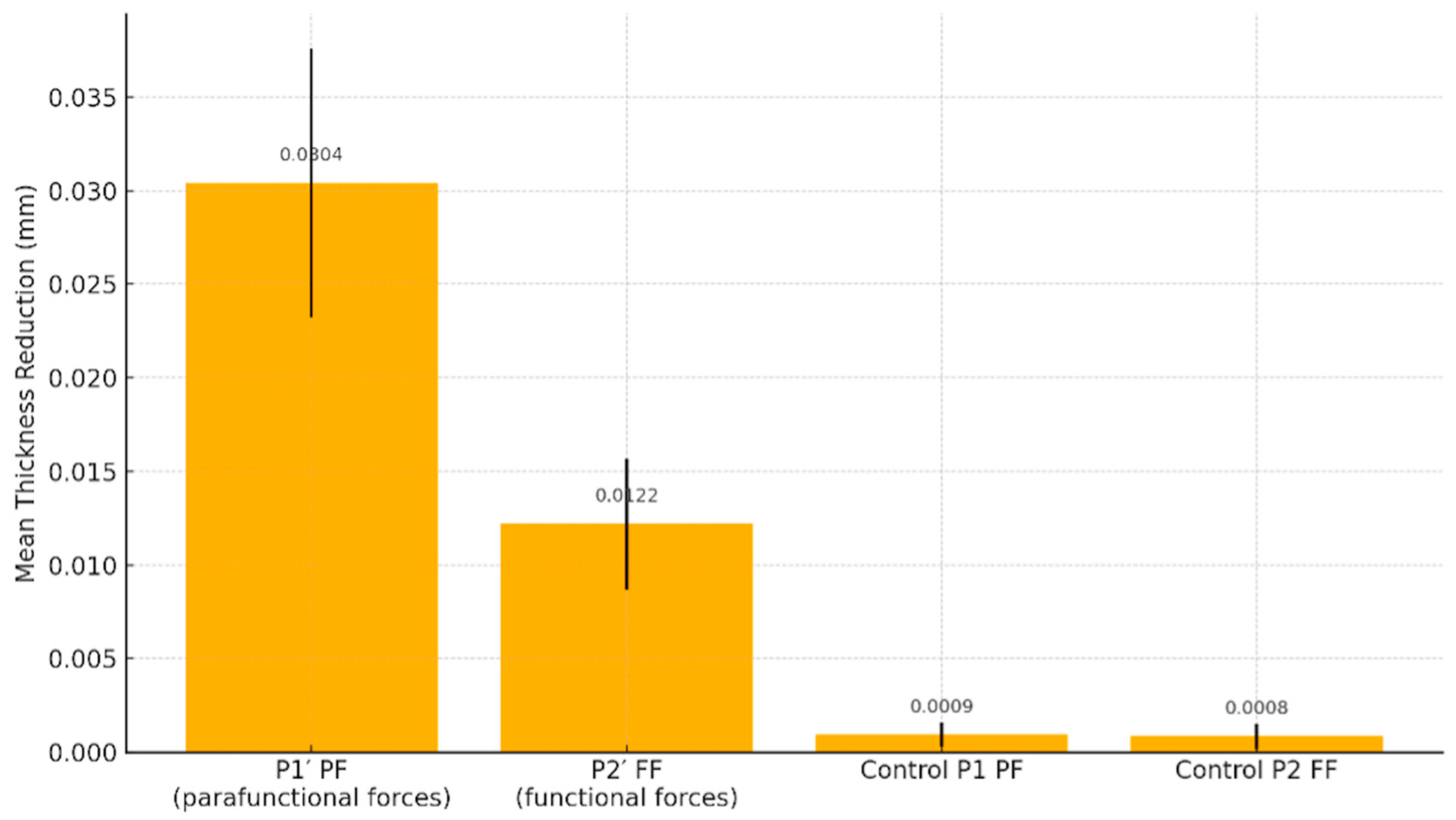Bruxism Simulation in Aligner Therapy: Effects on Restored Posterior Teeth
Abstract
1. Introduction
2. Materials and Methods
2.1. Experimental Design
2.2. Specimen Preparation and Restorative Procedure
2.3. Orthodontic Aligners Manufacturing
2.4. Masticatory Force Simulation
2.5. Surface Wear/Restoration Integrity Evaluation
2.5.1. Restorative Material Assessment
2.5.2. Aligner Integrity Analysis
2.6. Statistical Analysis
3. Results
4. Discussion
4.1. Impact of Parafunctional Forces on the Integrity of Composite Restorations
4.2. Material Performance and Aligner Selection
4.3. Study Limits and Future Research
5. Conclusions
Author Contributions
Funding
Institutional Review Board Statement
Informed Consent Statement
Data Availability Statement
Conflicts of Interest
References
- Alsammarraie, M.; Yen, E.; Romanyk, D.; Major, P. Current practice and application of finite element analysis in clear aligners: A scoping review. Semin. Orthod. 2025, 31. [Google Scholar] [CrossRef]
- Manfredini, D.; Winocur, E.; Guarda-Nardini, L.; Paesani, D.; Lobbezoo, F. Bruxism: Current knowledge and therapeutic aspects. J. Oral. Rehabil. 2013, 40, 580–601. [Google Scholar]
- Andreica, A.A.; Dudea, D.; Botoș, A. Surface electromyography assessment of masticatory muscles response to clear aligner therapy: An objective PRISMA standardized systematic review. Rom. J. Oral Rehabil. 2024, 16, 20. [Google Scholar] [CrossRef]
- Siotou, K.; Chountalas, T.; Katsavrias, A. The mechanical properties of orthodontic aligners of clear aligner after intraoral use in different time periods. Orthod. Craniofac. Res. 2025, 28, 253–260. [Google Scholar] [CrossRef]
- El-Mowafy, O.; Fenton, A.; Forsey, R.; Milenkovic, M. Wear resistance of direct composite resin restorations. J. Prosthet. Dent. 2009, 102, 123–130. [Google Scholar]
- Castroflorio, T.; Bargellini, A.; Manuelli, M.; Casasco, F.; Cugliari, G.; Deregibus, A. Effects of clear aligners on sleep bruxism: Randomized controlled trial. J. Biol. Regul. Homeost. Agents 2018, 32, 21–29. [Google Scholar]
- Crins, L.A.M.J.; Opdam, N.J.M.; Kreulen, C.M.; Bronkhorst, E.M.; Sterenborg, B.A.M.M.; Huysmans, M.C.D.N.J.M.; Loomans, B. Randomized controlled trial on the performance of direct and indirect composite restorations in patients with severe tooth wear. Dent. Mater. 2021, 37, 1645–1654. [Google Scholar] [CrossRef]
- Yilmaz, F.; Ozturk, Z.; Demirbas, A.; Kursun, S. Evaluation of the clinical success of direct restorations of endodontically treated posterior teeth in the presence of parafunction: A 12-month pilot study. Head Face Med. 2025, 21, 15. [Google Scholar] [CrossRef]
- Lobbezoo, F.; Ahlberg, J.; Glaros, A.G.; Kato, T.; Koyano, K.; Lavigne, G.J.; de Leeuw, R.; Manfredini, D.; Svensson, P.; Winocur, E. Bruxism defined and graded: A consensus report. J. Oral Rehabil. 2013, 40, 2–4. [Google Scholar] [CrossRef] [PubMed]
- Pradhan, D.; Parihar, V.; Tiwari, S.; Parihar, S. Occlusal stamp technique: A biomimetic approach in crafting occlusal topography. World J. Dent. 2025, 16, 497–504. [Google Scholar] [CrossRef]
- Micerium S.p.A. ENA Etch & Rinse One Bottle; Technical data sheet; Micerium S.p.A.: Avegno, Italy, 2024. [Google Scholar]
- Micerium S.p.A. ENA HRi Enamel; Technical data sheet; Micerium S.p.A.: Avegno, Italy, 2024. [Google Scholar]
- Micerium S.p.A. ENA HRi BioFunction Dentin; Technical data sheet; Micerium S.p.A.: Avegno, Italy, 2024. [Google Scholar]
- Caracostea (Objelean), A.; Morar, N.; Florea, A.; Soanca, A.; Badea, M.E. Two-body wear simulation influence on some direct and indirect dental resin biocomposites—A qualitative analysis. Acta Bioeng. Biomech. 2016, 18, 61–72. [Google Scholar]
- Sigma-Aldrich. Artificial Saliva SAE0149; Merck KGaA: St. Louis, MO, USA, 2025; Available online: https://www.sigmaaldrich.com/RO/en/product/sigma/sae0149 (accessed on 11 October 2025).
- Boitor, A.A.; Varvară, E.; Prodan, C.M.; Sava, S.; Dudea, D.; Objelean, A. The impact of simulated bruxism forces and surface aging treatments on two dental nano-biocomposites. Medicina 2023, 59, 360. [Google Scholar] [CrossRef]
- R Core Team. R: A Language and Environment for Statistical Computing, Version 4.3; R Foundation for Statistical Computing: Vienna, Austria, 2023.
- Jamovi. jamovi, Version 2.5; The jamovi project; Jamovi: Sydney, Australia, 2024.
- Ihssen, B.A.; Willmann, J.H.; Nimer, A.; Drescher, D. Effect of in vitro aging by water immersion and thermocycling on the mechanical properties of PETG aligner material. J. Orofac. Orthop. 2019, 80, 292–303. [Google Scholar] [CrossRef]
- Hadad, R.; Choufani, C.; El Osta, N.; Bassil-Nassif, N. Changes in surface morphology, chemical and mechanical properties of clear aligners during intraoral usage: A systematic review and meta-analysis. Int. Orthod. 2022, 20, 100610. [Google Scholar] [CrossRef]
- Albertini, P.; Mazzanti, V.; Mollica, F.; Pellitteri, F.; Palone, M.; Lombardo, L. Stress relaxation properties of five orthodontic aligner materials: A 14-day in vitro study. Bioengineering 2022, 9, 349. [Google Scholar] [CrossRef]
- Xiang, B.; Wang, X.; Wu, G.; Xu, Y.; Wang, M.; Yang, Y.; Wang, Q. The force effects of two types of polyethylene terephthalate glycerol-modified clear aligners immersed in artificial saliva. Sci. Rep. 2021, 11, 10052. [Google Scholar] [CrossRef]
- Dalaie, K.; Fatemi, S.M.; Ghaffari, S. Dynamic mechanical and thermal properties of clear aligners. Prog. Orthod. 2021, 22, 28. [Google Scholar] [CrossRef]
- Selvaraj, M.; Arumugam, L.; Sundararajan, R. Effect of oral environment on contemporary orthodontic materials: A review. J. Pharm. Bioallied Sci. 2023, 15 (Suppl. 1), S64–S70. [Google Scholar]
- Iliadi, A.; Kotsiomiti, E.; Eliades, T. Surface alterations and compound release from aligner composite attachments. Eur. J. Orthod. 2024, 46, cjae026. [Google Scholar] [CrossRef] [PubMed]
- Lobbezoo, F.; Ahlberg, J.; Raphael, K.G.; Wetselaar, P.; Glaros, A.G.; Kato, T.; Santiago, V.; Winocur, E.; De Laat, A.; De Leeuw, R.; et al. International consensus on the assessment of bruxism: Report of a work in progress. J. Oral Rehabil. 2018, 45, 837–844. [Google Scholar] [CrossRef] [PubMed]
- Verhoeff, M.C.; Lobbezoo, F.; Ahlberg, J.; Bender, S.; Bracci, A.; Colonna, A.; Dal Fabbro, C.; Durham, J.; Glaros, A.G.; Häggman-Henrikson, B.; et al. Updating the bruxism definitions: Report of an international consensus meeting. J. Oral Rehabil. 2025, 52, 1335–1342. [Google Scholar] [CrossRef] [PubMed]
- Ferracane, J.L. Resin composite—State of the art. Dent. Mater. 2011, 27, 29–38. [Google Scholar] [CrossRef]
- Rodrigues, S.A., Jr.; Ferracane, J.L.; Della Bona, A. Wear resistance of composite resins. J. Dent. 2010, 38, 176–181. [Google Scholar]
- Yap, A.U.; Shah, K.C.; Chew, C.L. Marginal gap formation of composites in dentine: Effect of water storage. J. Oral Rehabil. 2003, 30, 236–242. [Google Scholar] [CrossRef] [PubMed]
- Opdam, N.J.; Bronkhorst, E.M.; Roeters, J.M.; Loomans, B.A. Survival of restorations in clinical practice: Longevity and reasons for failure. J. Dent. Res. 2010, 89, 1063–1067. [Google Scholar] [CrossRef]
- Alrahlah, A.; Silikas, N.; Watts, D.C. Mechanical properties of dental composites. J. Appl. Oral Sci. 2013, 21, 224–231. [Google Scholar]
- Frankenberger, R.; Krämer, N.; Lohbauer, U.; Nikolaenko, S.A. Bond strength durability of adhesives. J. Adhes. Dent. 2003, 5, 57–67. [Google Scholar]
- Cayo-Rojas, C.F.; Hernández-Caba, K.K.; Aliaga-Mariñas, A.S.; Ladera-Castañeda, M.I.; Cervantes-Ganoza, L.A. Microleakage in class II restorations of two bulk fill resin composites and a conventional nanohybrid resin composite: An in vitro study at 10,000 thermocycles. BMC Oral Health 2021, 21, 619. [Google Scholar] [CrossRef]
- Hamburger, J.; Opdam, N.; Bronkhorst, E.M.; Huysmans, M. Indirect restorations for severe tooth wear: Fracture risk and layer thickness. J. Dent. 2014, 42, 413–418. [Google Scholar] [CrossRef]
- Zhang, Y.; Lawn, B.R. Long-term strength of ceramics for biomedical applications. J. Biomed. Mater. Res. B Appl. Biomater. 2004, 69, 166–172. [Google Scholar] [CrossRef]
- Dionysopoulos, D.; Gerasimidou, O. Wear of composite resin dental materials: A review of the literature. Restor. Dent. Endod. 2021, 46, e18. [Google Scholar] [CrossRef]
- Ilie, N.; Hickel, R. Resin composite restorative materials. Aust. Dent. J. 2011, 56 (Suppl. 1), 59–66. [Google Scholar] [CrossRef] [PubMed]
- Silva, E.M.; da Rocha, D.M.; Azevedo, L.D.M.; de Oliveira Dantas, L.; Machado, R.M.; Marchi, G.M. Effect of filler content on fatigue behavior of resin composites in different stress levels. J. Mech. Behav. Biomed. Mater. 2023, 145, 106847. [Google Scholar]
- Tomisaki, E.T.; Costa, M.B.; Silva, D.; Hoeppner, M.G.; de Almeida Cardoso, S. Parafunctional habits and their relationship with fractures of composite resin restorations. Res. Soc. Dev. 2021, 10, e18087. [Google Scholar] [CrossRef]
- Asaad, Y.M.; Alhudaithi, M.K.; Alazraqi, M.S.; Almugren, S.S.; Alhumizi, N.A.; Albesher, F.A.; Alhammad, Y.M.; Alzahrani, A.M.; Aljutaili, A.A.; Albaijan, A.A.; et al. The impact of occlusal forces on the longevity of restorations. Int. J. Community Med. Public Health 2023, 10, 3129. [Google Scholar] [CrossRef]
- Silvaroli, J.N. Parafunctional Habits Related to Clear Aligner Therapy. Master’s Dissertation, The University of Oklahoma Health Sciences Center, Oklahoma City, OK, USA, 2023. [Google Scholar]
- Bichu, Y.M.; Alwafi, A.; Liu, X.; Andrews, J.; Ludwig, B.; Bichu, A.Y.; Zou, B. Advances in orthodontic clear aligner materials. Bioact. Mater. 2022, 22, 384–403. [Google Scholar] [CrossRef]
- Heleiwa-Ferioli, T.; de la Cruz Vigo, S. Association between bruxism and the use of aligners in orthodontics. J. Clin. Exp. Dent. 2024, 16, e1247–e1255. [Google Scholar] [CrossRef]
- Šimunović, L.; Jurela, A.; Sudarević, K.; Bačić, I.; Malčić, A.I. Differential stability of one-layer and three-layer orthodontic aligner blends under thermocycling: Implications for clinical durability. Acta Stomatol. Croat. 2023, 57, 231–239. [Google Scholar] [CrossRef]
- Jia, L.; Wang, C.; Wang, C.; Song, J.; Zhang, B.; Zhang, Y. Efficacy of various multi-layers of orthodontic clear aligners: A simulated study. Comput. Methods Biomech. Biomed. Eng. 2022, 25, 623–632. [Google Scholar] [CrossRef]
- Elshazly, T.M.; Bourauel, C.; Ismail, A.; Ghoraba, O.; Aldesoki, M.; Salvatori, D.; Elattar, H.; Alhotan, A.; Alkabani, Y. Effect of material composition and thickness of orthodontic aligners on the transmission and distribution of forces: An in vitro study. Clin. Oral Investig. 2024, 28, 258. [Google Scholar] [CrossRef]
- Chen, S.M.; Lee, K.C.; Hsu, J.T.; Chen, Y.J. Force degradation study on aligner plates immersed in artificial saliva. J. Dent. Sci. 2023, 18, 1850–1858. [Google Scholar] [CrossRef] [PubMed]
- Bock, H.L.; Bock, J.J.; Karbach, F.; Ludwig, B.; Schupp, W.; Funke, J.; Haubrich, J. Material Properties and First Clinical Applications of CA Pro, a Novel Aligner Foil. J. Aligner Orthod. 2022, 6, 163–181. [Google Scholar]
- Atlas, A.M.; Behrooz, E.; Barzilay, I. Can bite-force measurement play a role in dental treatment planning, clinical trials, and survival outcomes? A literature review and clinical recommendations. Quintessence Int. 2022, 53, 866–876. [Google Scholar]
- Li, X.; Xu, T.; Wang, X.; Liu, Y.; Wang, Y. Changes in Mechanical Properties of Invisalign Aligners after Intraoral Aging. Am. J. Orthod. Dentofac. Orthop. 2022, 161, e458–e466. [Google Scholar]
- Rosentritt, M.; Behr, M.; Preis, V. In vitro performance of orthodontic thermoplastic materials. J. Mech. Behav. Biomed. Mater. 2021, 114, 104214. [Google Scholar]
- Lombardo, L.; Martines, E.; Mazzanti, V.; Arreghini, A.; Mollica, F.; Siciliani, G. Mechanical properties of aligner materials. Angle Orthod. 2017, 87, 896–902. [Google Scholar]
- Farronato, G.; Maspero, C.; Alberti, G.; Caprioglio, A. Stress and Strain Evaluation of Aligners: A Combined FEM and Experimental Approach. Prog. Orthod. 2020, 21, 26. [Google Scholar]
- Smith, T.M.; Nguyen, T.T.; Huang, J.; Kurylo, M.P.; Reher, R.; O’Reilly, M.; Park, J.H. Influence of Thermoforming on the Mechanical Properties of Orthodontic Aligner Materials. Am. J. Orthod. Dentofac. Orthop. 2022, 161, e203–e211. [Google Scholar]
- Lee, S.Y.; Park, J.H.; Kim, J.H.; Choi, S.H.; Cha, J.Y. Effect of Repeated Insertion and Removal on the Mechanical Properties of Clear Thermoplastic Orthodontic Aligners. Korean J. Orthod. 2021, 51, 326–335. [Google Scholar]
- Bucci, R.; D’Antò, V.; Michelotti, A. Considerations on Clear Aligner Therapy in Patients with Temporomandibular Disorders and/or Bruxism. Semin. Orthod. 2025, 31, 157–165. [Google Scholar] [CrossRef]
- Ryu, J.H.; Kwon, J.S.; Jiang, H.B.; Cha, J.Y.; Kim, K.M. Effects of Thermoforming on the Physical and Mechanical Properties of Thermoplastic Materials for Transparent Orthodontic Aligners. Korean J. Orthod. 2018, 48, 316–325. [Google Scholar] [CrossRef] [PubMed]
- Staderini, E.; Chiusolo, G.; Guglielmi, F.; Papi, M.; Perini, G.; Galli, M.; Gatto, R. Effects of Thermoforming on the Mechanical, Optical, Chemical, and Morphological Properties of PET-G: In Vitro Study. Polymers 2024, 16, 203. [Google Scholar] [CrossRef] [PubMed]
- Albarran-Martínez, L.; Rodríguez-Vilchis, L.E.; Contreras-Bulnes, R.; Moyaho-Bernal, M.L.A.; Teutle-Coyotecatl, B. Effect of different industrialized acid beverages on the surface roughness of flowable composite resins: In vitro study. J. Clin. Pediatr. Dent. 2023, 47, 152–161. [Google Scholar] [CrossRef] [PubMed]
- Cacciafesta, V.; Sfondrini, M.F.; Lena, A.; Scribante, A.; Vallittu, P.K.; Lassila, L.V. Force levels of fiber-reinforced composites and orthodontic stainless steel wires: A 3-point bending test. Am. J. Orthod. Dentofac. Orthop. 2008, 133, 410–413. [Google Scholar] [CrossRef]
- España-Pamplona, P.; Bernés-Martínez, L.; Andrés-Castelló, C.; Bolás-Colveé, B.; Adobes-Martín, M.; Garcovich, D. Changes in the Oral Microbiota with the Use of Aligners vs. Braces: A Systematic Review. J. Clin. Med. 2024, 13, 7435. [Google Scholar] [CrossRef]







| Material | Manufacturer | Monomer Matrix | Filler Content | Lot Number |
|---|---|---|---|---|
| ENA HRi BioFunction Dentin | Micerium S.p.A. (Avegno, Italy) | Urethane dimethacrylate (UDMA), tricyclodecane dimethanol dimethacrylate (TCDDM) | 74% by weight (60% by volume); 0.005–0.05 µm silicon dioxide and 0.2–3.0 µm glass fillers | 2019008149 |
| ENA HRi BioFunction Enamel | Micerium S.p.A., (Avegno, Italy) | Urethane dimethacrylate (UDMA), tricyclodecane dimethanol dimethacrylate (TCDDM); BPA-free, Bis-GMA-free | 74% by weight (60% by volume); nanoparticle aggregates, fluoride-releasing, high radiopacity (~250% Al) | 2021002871 |
| Measure | Mean | Median | SD | SE |
|---|---|---|---|---|
| RMS Error F | 21.5 | 21.9 | 1.82 | 0.469 |
| RMS Error PF | 33.5 | 32.8 | 4.90 | 1.266 |
| Comparison | Test | Statistic | df | p | Mean Difference | SE Difference | 95% CI Lower | 95% CI Upper |
|---|---|---|---|---|---|---|---|---|
| RMS error F vs. RMS error PF | Student’s t | −8.54 | 14.0 | <0.001 | −11.9 | 1.39 | −14.9 | −8.92 |
| RMS error F vs. RMS error PF | Wilcoxon W | 0.00 | <0.001 | −11.3 | 1.39 | −14.6 | −8.63 |
Disclaimer/Publisher’s Note: The statements, opinions and data contained in all publications are solely those of the individual author(s) and contributor(s) and not of MDPI and/or the editor(s). MDPI and/or the editor(s) disclaim responsibility for any injury to people or property resulting from any ideas, methods, instructions or products referred to in the content. |
© 2025 by the authors. Licensee MDPI, Basel, Switzerland. This article is an open access article distributed under the terms and conditions of the Creative Commons Attribution (CC BY) license (https://creativecommons.org/licenses/by/4.0/).
Share and Cite
Boitor, A.A.; Objelean, A.; Gasparik, C.; Burde, A.V.; Colosi, H.A.; Dudea, D. Bruxism Simulation in Aligner Therapy: Effects on Restored Posterior Teeth. J. Clin. Med. 2025, 14, 7877. https://doi.org/10.3390/jcm14217877
Boitor AA, Objelean A, Gasparik C, Burde AV, Colosi HA, Dudea D. Bruxism Simulation in Aligner Therapy: Effects on Restored Posterior Teeth. Journal of Clinical Medicine. 2025; 14(21):7877. https://doi.org/10.3390/jcm14217877
Chicago/Turabian StyleBoitor (Andreica), Amelia Anita, Adriana Objelean, Cristina Gasparik, Alexandru Victor Burde, Horațiu Alexandru Colosi, and Diana Dudea. 2025. "Bruxism Simulation in Aligner Therapy: Effects on Restored Posterior Teeth" Journal of Clinical Medicine 14, no. 21: 7877. https://doi.org/10.3390/jcm14217877
APA StyleBoitor, A. A., Objelean, A., Gasparik, C., Burde, A. V., Colosi, H. A., & Dudea, D. (2025). Bruxism Simulation in Aligner Therapy: Effects on Restored Posterior Teeth. Journal of Clinical Medicine, 14(21), 7877. https://doi.org/10.3390/jcm14217877










